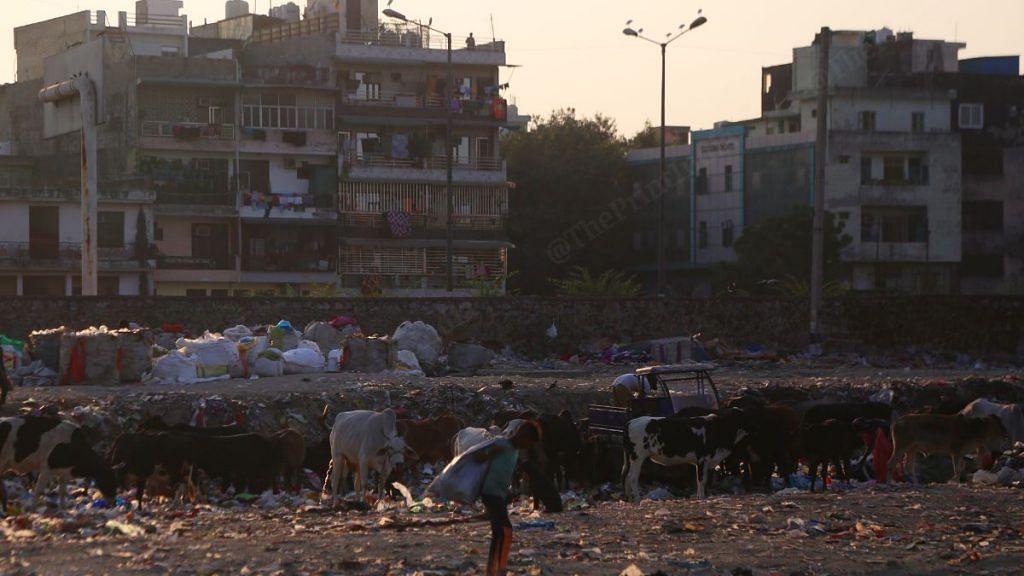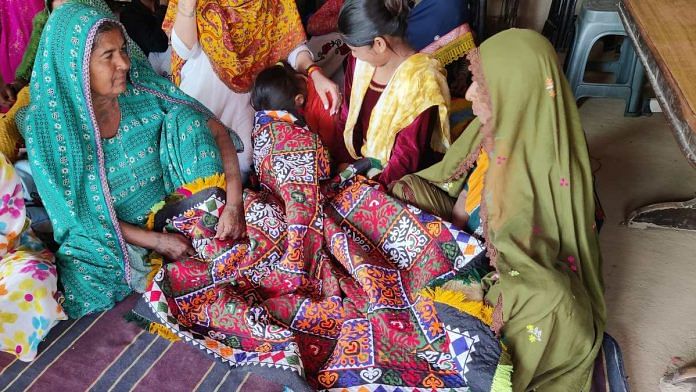New Delhi: For the first time since she left Pakistan six years ago, Dhani Thakur had money to buy made-in-India clothes for herself and her two daughters. It was a milestone in her life as a Hindu refugee living in Adarsh Nagar, Delhi. The quilts she stitches to pass the time are now in demand, fetching them thousands of rupees.
It’s been two years since that landmark shopping trip. Today, the quilts are in huge demand, and Dhani is one of six women refugees at Adarsh Nagar who have taken up the craft.
In an open room next to the kaccha house she shares with 20 family members, including her in-laws, she unfurls a green Ralli quilt with chains of red and yellow flowers embroidered on it. It took her more than three months to sew, and she expects to earn around Rs 4,000 for it.
“This work represents the culture of Sindh, which we learned there, passed down from generation to generation. Every woman in Sindh knows how to do this,” said Dhani, who moved into the Adarsh Nagar refugee camp in 2018.

For families like the Thakurs, who waited nearly a decade for electricity, the quilts offer a path to a life with dignity.
Dhani’s face lit up as she recalled that shopping trip to the local weekly bazaar. That day, everything seemed brighter, more vibrant. She picked out a navy blue cloth with floral patterns and had it stitched into a skirt, top, and dupatta for herself.
“It gives me hope,” she said.
Also Read: No burqa, no men to be wary of—Daryaganj’s Parda Bagh brings women out to laugh, talk, play
The business of quilts
In a large mud room, a group of women sit together, each working on a different quilt. It’s a community affair. Grandmothers, mothers, and daughters gather around sewing machines, laughing, joking, and sharing ideas. The children help out when they’re not in school or playing with their friends.
Dhani’s mother-in-law, Gulal, unfurls a vivid blue quilt covered with vines and flowers of every shape and size. The women have created more than four design templates, including patchwork, appliqué, and embroidery (kadai). Each quilt takes over three months to make, incorporating intricate designs of flowers, leaves, and sometimes animals like elephants and camels.
Along with Dhani, five other women make these quilts, which are now sold by the Rouble Nagi Art Foundation on Studio Saksham, an e-commerce platform. Some pieces sell for as much as Rs 15,000 online.

No two quilts are alike. Dhani pointed to a yellow cotton quilt embroidered with red flowers.
“It took me one week to make just one flower. I completed the quilt in almost three months, and now I have to finalise it by adding some borders,” she said.
The quilt-making business began almost by chance. In 2022, visual artist Rouble Nagi was in Adarsh Nagar, helping children secure school admissions and running educational programmes. During a visit, she noticed a quilt on Dhani’s bed. Floored by the intricacy and precision of the embroidery, she started talking to the women and struck a deal with them.
Now, she buys the finished quilts for a fixed price and sells them on her e-store, Studio Saksham, which promotes local handicrafts through her NGO.
“The thread work, designs, and embroidery on these quilts are completely different from Indian designs and work, showcasing a unique culture. They are distinct, which is something people are liking more,” said Nagi.
Despite their growing confidence, however, the women say their work is undervalued.
“We still feel that we are getting very little for what we are producing. It takes a lot of time and hard work to complete one quilt. But we hope that our work will reach more and more people, and we will start earning more for our hard work,” said Dhani, as others in the group nodded in agreement.

The threads used for these quilts are still sourced from Pakistan.
“The ones available in India are either too thick for the kind of embroidery we do,” said Dhani. “Whenever one of our relatives or friends comes to India, we ask them to bring the threads.”
The women work on the Rallis in the afternoons and evenings, after completing their household chores. By then, most of the men are out at work—some as daily wage labourers, others in local shops. Dhani’s brother-in-law owns an e-rickshaw, which he bought with his savings from Pakistan and loans from friends. Another male relative earns around Rs 12,000 a month selling plastic mobile covers and tempered glass for smartphones and earbuds.
Kamal Lal, 47, came to India with his family from Pakistan in 2016 and has lived in the Adarsh Nagar camp ever since. By 2017, he was able to buy a rickshaw. He still has relatives in Pakistan who are trying to come to India, but he has no plans to return.
“We have always considered India our home, and now, as people are starting to accept us, it truly feels like our own land,” he said.
From persecution to possibility
As minorities in Pakistan, the Thakurs were barred from buying land, starting a business, or practising their religion freely. Dhani’s quilt-making has shown them that in India, there are opportunities they can tap.
Today, more than 300 Hindu families live in Delhi’s Adarsh Nagar refugee camp, having left behind a life of persecution and forced conversions in Pakistan.
The Thakurs left Sindh for India in 2018 in search of freedom, security, and a place to call their own. None of them miss the life they left behind in Pakistan.
“There was hardship, fear, and lack of opportunity,” said Gulal.
Another woman, Dhani’s sister-in-law Mali, stopped working on her pink quilt and joined the conversation.
“We may have brought our craft from Pakistan with us, but there is no nostalgia,” she said.

But life in Adarsh Nagar is tough. It was only in 2022, after a Delhi High Court order, that they finally got electricity. Now, they are fighting for clean running water, cemented roads, education, and, most importantly, citizenship.
“Yes, we are battling here as well for many things, but we are free here. We can practise our religion openly, visit our places of worship, and no one will question us for that,” said Gulal.
The ‘Pakistani’ stigma
At Adarsh Nagar, an Aadhaar card is the most prized possession. Without one, even something as basic as school admission is out of reach. Dhani’s elder daughter Nandini now 15, was only able to enroll in Government Girls Secondary School in Majlis Park, Adarsh Nagar, after she got her Aadhaar card in 2021.
Her classroom is full of chatter, with nearly 30 girls sitting at their benches, laughing, talking, and sharing notes. But Nandini sits apart on the last bench, lowering her head when someone tries to make eye contact. Though she’s been attending the school since Class 6, she’s still the “girl from Pakistan”.
Her classmates are curious about her life there, but like her parents, she prefers not to revisit it. The first day at school in India had been nerve-racking.

“I was really afraid. The whole time, I was thinking, ‘What will happen if somebody asks me where I’ve come from and what I’m doing here? Should I go back to Pakistan? It’s their country,’” she said. But while there’s curiosity, nobody suggested she leave India.
Dhani’s younger daughter, 13-year-old Ashwariya, studies in the same school and had a similar experience. She recounts how students would always ask her where she came from and why. And after hearing “Pakistan”, they would keep their distance. Language was another issue—like most Hindu refugees in Adarsh Nagar, she was fluent in Sindhi and Urdu, but not Hindi.
“Language was really a barrier in making friends because when someone asked me something, I couldn’t answer properly,” said Ashwariya. But now, she speaks Hindi fluently. “I learned by reading more Hindi books and talking to students at school.”
For many refugee children, though, the bigger hurdle is paperwork. Without an Aadhaar card, they can’t even enroll in school.
To help them, Dhani’s husband, Vikram Thakur, 36, started holding informal classes. Back in Pakistan, he had been a primary school teacher at a government school. His efforts were recognised by the Rouble Nagi Art Foundation, and together, they now teach over 400 children at the Adarsh Nagar Refugee Camp. The children receive basic education until they can secure admission to a formal school.
“I always wanted to educate children, no matter where I am. That’s why I began teaching the kids in the slum and later joined the NGO,” said Vikram.
Also Read: Granted Indian citizenship under CAA, Hindu migrants from Pakistan embrace ticket to ‘freedom’
Fitting in
For Dhani, Gulal, and the other women, fitting in is important. But unlike the men who go to work or the children who attend government schools, their world rarely extends beyond the refugee camp.
“Whenever we go out, mostly to the weekly markets or just to wander, we never wear the traditional clothes we wear at home. We want to look Indian, so we wear saris,” said 24-year-old Mali, adjusting her dupatta over her head. At home, she wears a ghagra with a matching blouse.
The refugee camp is decorated with BJP party flags, and residents are grateful to Prime Minister Narendra Modi and the Citizenship Amendment Act for giving them a future in India.
“I want to get a voter ID card first because I want to vote for Modi. We Hindus are here because of him, and now we can call ourselves Indian,” said Gulal.
(Edited by Asavari Singh)






